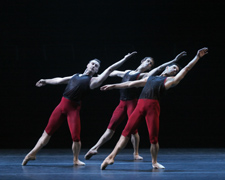
Jack Anderson
Wheeldon's Morphoses
 |
| "Morphoses" by The Wheeldon Company. Photo by Erin Baiano |
Morphoses/The Wheeldon Company
New York City Center, 55th Street between Sixth and Seventh Avenues
Oct. 17-21, 2007 (closed)
Information: (212) 247-0430
Reviewed by Jack Anderson, Oct. 23, 2007
The inaugural New York season of Christopher Wheeldon's new troupe attracted large enthusiastic audiences, and in many ways the cheers were justified. Wheeldon is a talented choreographer, he used live music, and the fact that Morphoses included principals and soloists from several companies suggests that dancers enjoy working with him. Nevertheless, there were problems of personnel and repertory.
For one thing, this was not really a company, but an aggregation of individuals akin to those pickup assemblages promoted under such titles as "Great Moments of Ballet" or "Illustrious Superstar and Friends," except that while those programs tend to feature warhorses like the "Corsaire" and "Black Swan" pas de deux, Wheeldon was determinedly contemporary.
Although that in itself was admirable, it still must be said that the present repertory is limited and does not reveal Wheeldon's versatility. Too many works were simultaneously lyrical and athletic plotless dances that made strenuous movements look effortless. There is nothing necessarily wrong with this. Yet some pieces seemed to have no real point beyond displaying ease within effort.
Wheeldon has created many other kinds of things in the past. He can play intricate games of form and perception, as in the mirror images of "Scènes de Ballet." A wicked comic gift was evident in the deceptively titled "Variations Sérieuses." And he appears to have a flair for story-telling, as such diverse pieces as "Carousel, a Dance," "Carnival of the Animals," and "An American in Paris" demonstrate.
Abstraction prevailed at the City Center. "Morphoses," the dance that gave his organization its name, is already familiar, thanks to the New York City Ballet. Set to music of Ligeti, it remains a fascinating study in shape shifting, beginning and ending with dancers in a huddled mass on the floor. When they rise at the start, they keep changing shapes, suggesting geometrical formations in constant flux, or biological organisms constantly evolving and finally becoming human beings in cooperative or competitive situations. Among the dancers, Wendy Whelan, so often Wheeldon's muse, moved with amazing fluidity.
"Mesmerics," to Philip Glass, abounded with mysteries. Eight cellists were revealed on stage in shadows as couples appeared to be drawn by their music to dance beneath a light suspended like a street lamp above them, making them sometimes resemble lovers meeting furtively on nocturnal sidewalks. Then the cellists vanished, music rose from the pit, and the choreographic allegros that followed grew agitated and, when the cellists returned, even combative. Yet "Mesmerics" concluded quietly. A lot happened in this curious piece, much of it inexplicable, but most of it interesting enough to suggest that Wheeldon was guided by some real, although essentially very personal, idea.
In a lighter mood, his "Dance of the Hours" from
"La Gioconda" was a spoof of old-fashioned opera-ballet, done
with such insouciance that it became divine nonsense.
It was hard to discern the point of other Wheeldon offerings, or to care
much about them. He seems inordinately fond of having dancers curl about
their partners and raise one another in tricky lifts that have little
apparent significance other than their sheer ingenuity. If the juxtapositions
of songs by Chopin and Kurt Weill in "There Where She Loved"
were meant to suggest contrasts between innocent and worldly lovers, the
choreography never made the distinctions eloquent. "Fools' Paradise"
was a collection of self-consciously clever groupings with many upside-down
and sideways positions. "Prokofiev Pas de Deux," danced by Alina
Cojocaru and Nehemiah Kish on the night I saw it, involved slowly unspooling
movements and complicated overhead lifts.
Wheeldon has wisely announced that he hopes to present other choreographers' ballets as well as his own, and his second program had two pieces by himself but four by other people. Unfortunately, most were little more than facile cling-twist-and-lift choreography. Edwaard Liang set "Vicissitude" to the movement from Schubert's "Death and the Maiden" Quartet that has inspired several ballets about ominous death-figures and delicate damsels. Disdaining drama, Liang created a pas de deux for Maria Kowroski and Tyler Angle that had many well-crafted clingings and twistings, yet never suggested the ups and downs of fortune hinted at in his title. Aesha Ash and Gonzalo Garcia coped easily with the odd nervous tilts of William Forsythe's "Slingerland Pas de Deux," and Oxana Panchenko and Michael Nunn balanced with aplomb in Liv Lorent's "Propeller."
The best work by a choreographer other than Wheeldon was Michael Clark's "Satie Stud," to Satie piano music. Although Clark has long seemed to enjoy playing the bad boy of British ballet, this solo for William Trevitt, despite its saucy title, was a serious and visually arresting piece which required Trevitt to take and sustain one sculptural pose after another, his slow progress from pose to pose becoming both stoic and heroic.
So here was Wheeldon's company off to a start which, because
it was neither a triumph nor a catastrophe, may well set ballet fans of
all esthetic persuasions chattering away in heated discussions until his
next season arrives. As for Wheeldon, he'll presumably just continue following
his own creative path. He's ambitious, he's smart, and he's gifted. (If
he occasionally makes mistakes, well, who doesn't?) So what's next?
| museums | NYTW mail | recordings | coupons | publications | classified |
